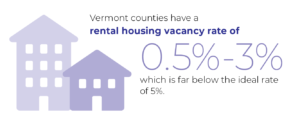Housing and Homelessness: Ensure Access to Safe, Stable, and Affordable Housing
The pandemic and the 2023 flooding illuminated and exacerbated the challenges too many Vermonters face finding and maintaining affordable housing The crisis is of particular concern for families with young children who are at risk for and are currently experiencing homelessness. Currently, 1,273 households rely on state emergency housing programs (the Pandemic Era Hotel/Motel Transition Program and the traditional General Assistance Emergency Housing Program). At least 196 of these households are families with children. The Hotel/Motel Program is set to end in April, leaving the outdated and more limited General Assistance Program as the only emergency housing option when shelter beds are not available, which will result in many Vermont households without shelter.
The Alliance supports the Housing & Homelessness Alliance of Vermont (HHAV) in its request for the Legislature to do the following:
- Make $160 million in housing capital available for affordable housing and shelter development and preservation
- Provide full statutory funding of the Vermont Housing and Conservation Board through the Property Transfer Tax
- Re-envision the state-run emergency housing system
- Ensure adequate funding for General Assistance emergency housing and households remaining after the end of the Hotel/Motel program (the June Cohort) while any programmatic changes are implemented
- Adequately fund the state programs that provide support and services for households in temporary and permanent housing, with particular attention to housing stability and retention services designed to increase sustainability and prevent homelessness for Vermont families.
Results: Emergency Housing reduced, minimal investments in Affordable Housing
NOTE – this version provides a compressed summary of the results of the session. For a more detailed accounting, please see the expanded version of this document here.
Emergency Housing
The Governor’s Recommended FY25 Budget proposed very large cuts to the General Assistance (GA) Emergency Housing Program that would return GA to its limited, pre-pandemic scope.
The House FY25 Budget rejected this framing, and proposed funding to allow the GA program to serve more of those in need. The House also passed H.879, which for the first time created an emergency housing program in statute. The program would have begun in FY26, with an Advisory Committee and Task Force set up to help further develop the details of the new program.
The Senate did not support most of the steps outlined in H. 879. While they favored a more expansive GA program than the Governor, they proposed a smaller program than the one supported by the House.
After extensive discussions between the Administration, the House, and the Senate, the final FY25 Budget includes $44 million to fund GA ($7.5m in base, $16.5m in one-time, and $20m in contingency funds which will be available if future tax revenues come in as predicted), with a Task Force to develop recommendations for creating a state emergency housing program in future years. The agreement provides households with vulnerable members unlimited access to shelter in hotels/motels from December 1 to March 31 and limited access at other times. Households that do not meet eligibility criteria do not have access to emergency shelter in hotels and motels. To address this, the Budget includes an additional $10 million in contingency funds to develop emergency shelter capacity.
This emergency housing plan is better than the initial one outlined in the Governor’s proposal, thanks to considerable work from the Legislature, especially the House. However, it will still leave many vulnerable and non-vulnerable Vermonters without shelter during significant portions of the year.
Additional Affordable Housing Investments
The Governor’s Recommended FY25 Budget included full statutory funding of $24.6 million for the Vermont Housing and Conservation Board (VHCB). Both the House and the Senate supported this part of the Governor’s proposed budget. Unfortunately, it did not include significant additional funding to maintain the substantial, sustained investments necessary to address the affordable housing and homelessness crisis in Vermont.
The House developed comprehensive housing legislation, H.829, that included a 10-year housing plan. Funding for the needed investments would come from an increase in Property Transfer taxes and a new personal income tax bracket for very high-income Vermonters. The Senate was not in agreement with the House funding proposal, either in scope or funding methodology. As Senate leadership felt the best way to support creating new housing was through regulatory reform rather than additional investment, H. 829 was not taken up by the Senate.
After much negotiation between various House and Senate committees, a compromise was struck that will generate $15.6 million in FY25 through an increase in the Property Transfer tax to support a number of housing generation and homelessness prevention programs.
The FY25 Budget also includes $25.8 million through an existing grant program for community programs to provide a variety of supports to households experiencing homelessness, and $7 million in funding for several new community-run shelters scheduled to open later this year.
Additional funding for housing initiatives in FY25 may be realized if surplus funds are available. This funding includes $30 million for affordable housing and shelter capacity, $25 million for middle-income homeownership, and $10 million for other programs.
LEAD ORGANIZATION: Housing and Homelessness Alliance of Vermont

Data and Talking Points
- On average, over 3700 children aged 9 and under were in households enrolled in Reach Up at one point in FFY22
- Vermont counties have a rental housing vacancy rate of 0.5% to 3% which is far below the ideal rate of 5%
